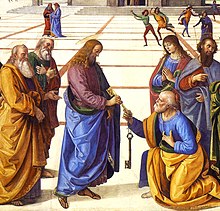 |
| Part of a series on the |
| Canon law of the Catholic Church |
|---|
|
|

Papal appointment was a medieval method of selecting the Pope. Popes have always been selected by a council of Church fathers; however, Papal selection before 1059 was often characterized by confirmation or nomination by secular European rulers or by the preceding pope.[1] The later procedures of the Papal conclave are in large part designed to prohibit interference of secular rulers, which to some extent characterized the first millennium of the Roman Catholic Church, e. g. in practices such as the creation of crown-cardinals and the claimed but invalid jus exclusivae. Appointment may have taken several forms, with a variety of roles for the laity and civic leaders, Byzantine and Germanic emperors, and noble Roman families.[2] The role of the election vis-a-vis the general population and the clergy was prone to vary considerably, with a nomination carrying weight that ranged from nearly determinative to merely suggestive, or as ratification of a concluded election.
The practice originated in late antiquity, where on many occasions the Roman Emperor stepped in to resolve disputes over the legitimacy of Papal contenders. An important precedent from this period is an edict of Emperor Honorius, issued after a synod he convoked to depose Antipope Eulalius. The practice passed to, and grew with, the King of the Ostrogoths, and then the Byzantine Emperor (or his delegate, the Exarch of Ravenna). After an interregnum, the Kings of the Franks and the Holy Roman Emperor (whose selection the Pope also sometimes influenced), generally assumed the role of confirming Papal elections. For a period, today known as the "saeculum obscurum", the practice passed from the Emperor to powerful Roman nobles—the Crescentii and then the Counts of Tusculum.
In many cases, the Papal coronation was delayed until the election had been confirmed. Some antipopes were similarly, putatively, appointed. The practice ended with the conclusion of the Investiture Controversy (c.f. confirmation of bishops) due largely to the efforts of Cardinal Hildebrand, the future Pope Gregory VII, who was a guiding force in the selection of his four predecessors, and the 1059 Papal bull In Nomine Domini of Pope Nicholas II; some writers consider this practice to be an extreme form of "investiture" in and of itself.[3]
Although the practice was forbidden by the Council of Antioch (341) and the Council of Rome (465), the Bishops of Rome, as with other bishops, often exercised great control over selection of their successors, even after the sixth century.[4] In addition, most popes of the fourth to twelfth centuries were nominated or confirmed by a secular power.[4]
- ^ Fanning, William. "Papal Elections." The Catholic Encyclopedia Vol. 11. New York: Robert Appleton Company, 1911. 6 October 2017]
- ^ Cite error: The named reference
g20was invoked but never defined (see the help page). - ^ Brauer, Jerald C., and Gerrish, Brian Albert. 1971. The Westminster Dictionary of Church History. Westminster Press. ISBN 0-664-21285-9. p. 216.
- ^ a b Josep M. Colomer and Iain McLean. (1998). "Electing Popes: Approval Balloting and Qualified-Majority Rule". The Journal of Interdisciplinary History, Vol. 29, No. 1, pp. 1-22.
© MMXXIII Rich X Search. We shall prevail. All rights reserved. Rich X Search
